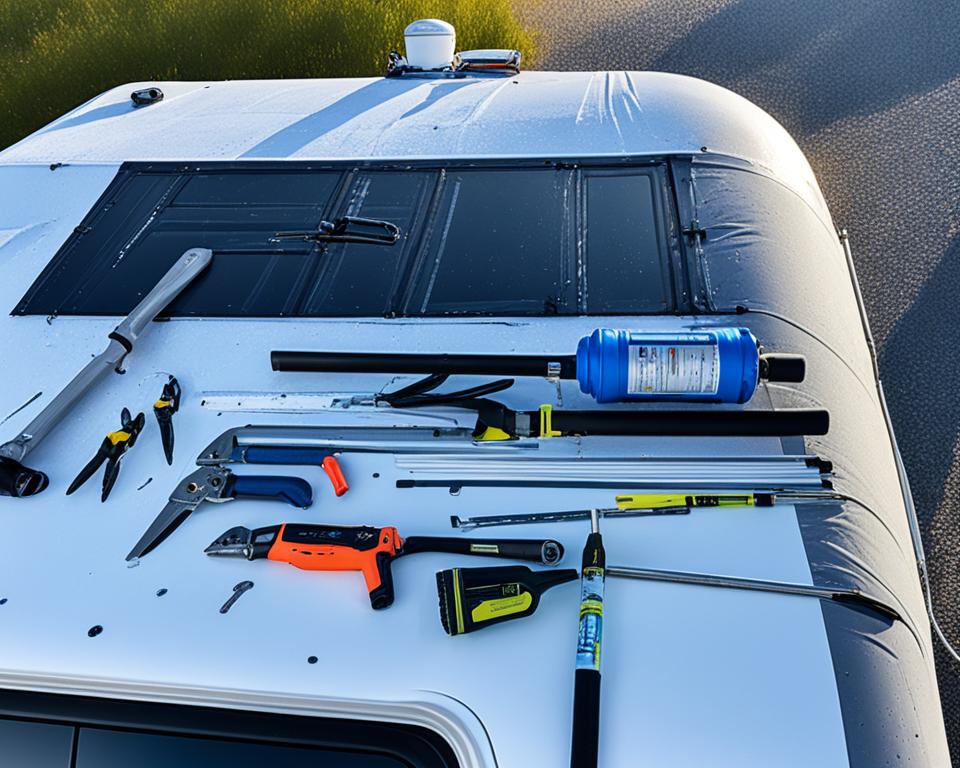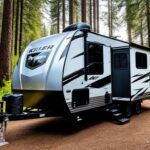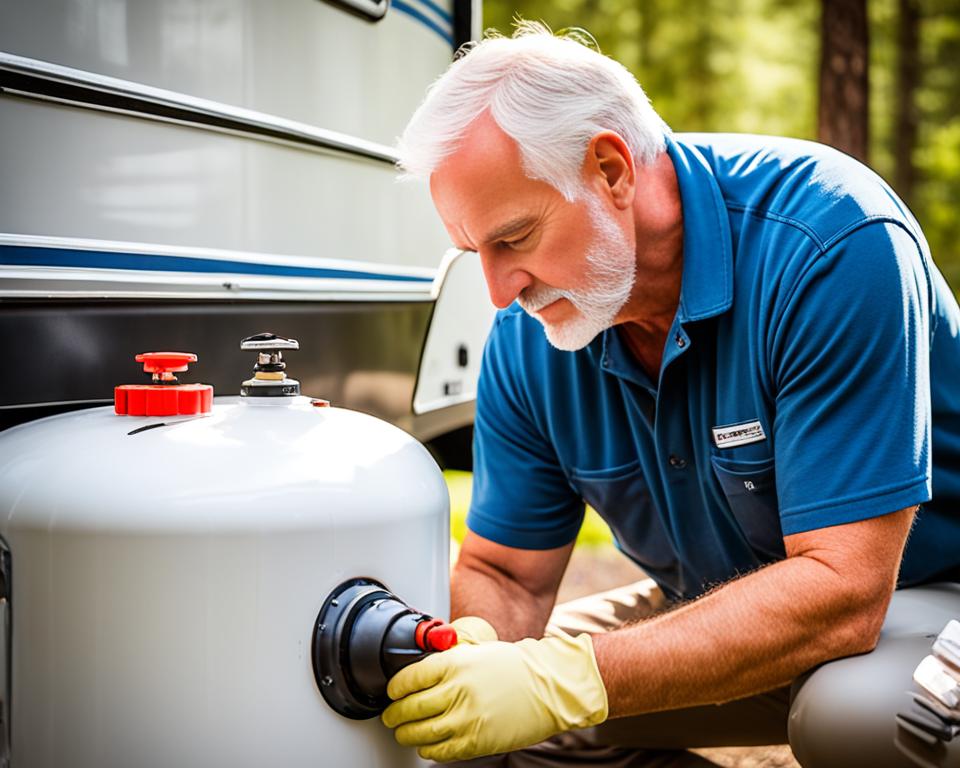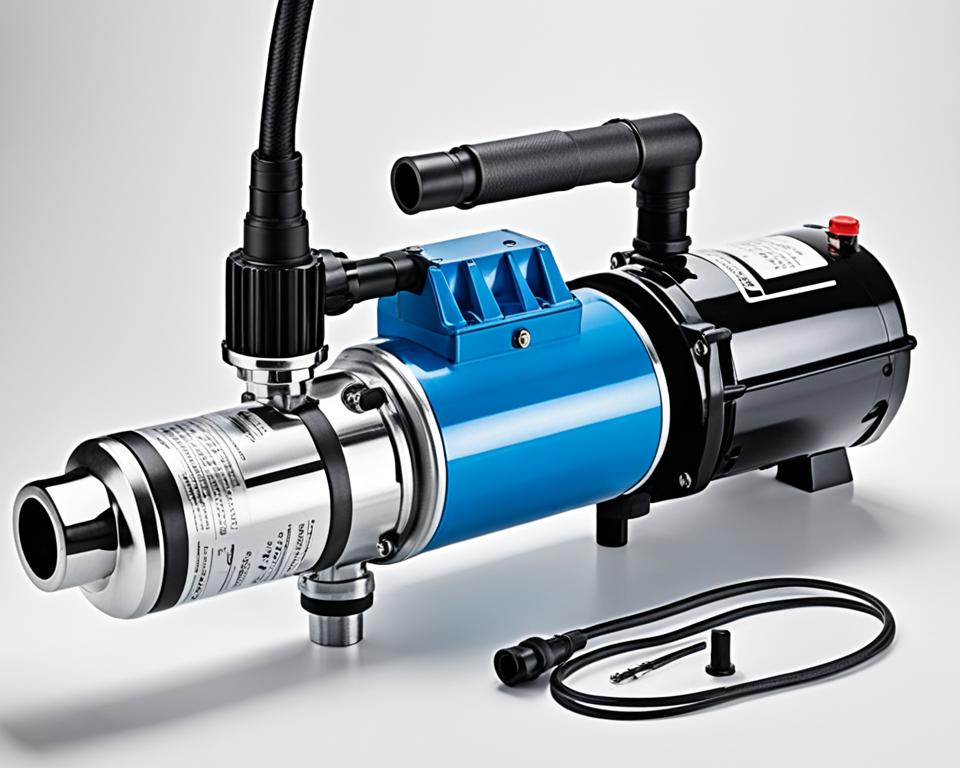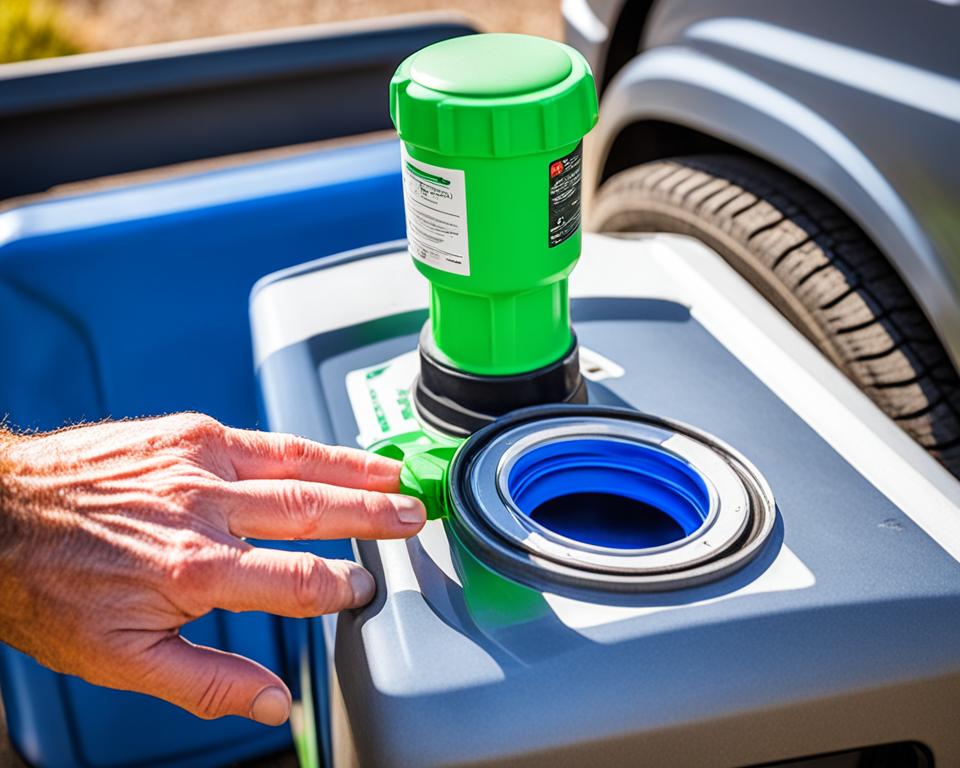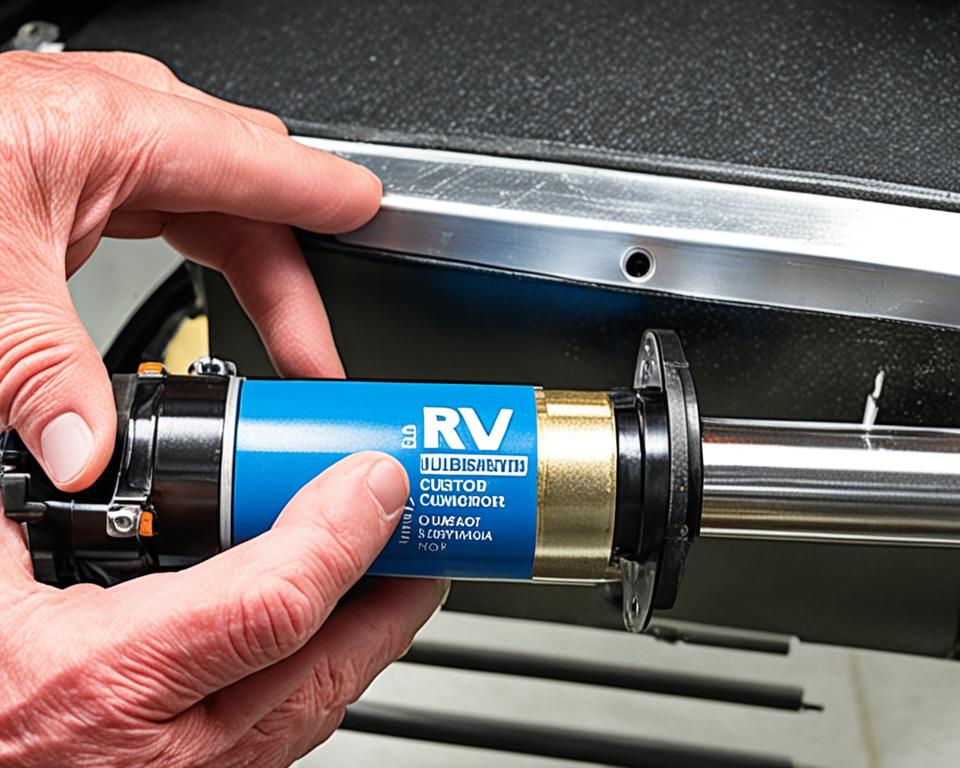Dealing with a leaky RV roof can be a frustrating experience. Not only can it cause significant damage to the interior and belongings, but it can also spoil your RVing adventures. The good news is that with the right tools and materials, you can easily fix the roof leak yourself, saving time and money on professional repairs.
When it comes to DIY RV roof leak repair, preparation is key. Before you begin the repair, make sure you have all the necessary materials and tools. One highly recommended option is an RV roof restoration kit, like the one provided by XYZ Roofing. These kits come with everything you need to effectively repair your RV roof, ensuring a long-lasting solution.
Before starting the actual repair, it’s essential to clean and prepare your RV roof properly. Use eco-friendly cleaners to remove dirt and debris, and then use acetone as a primer to ensure optimal adhesion of the repair materials.
For sealing gaps and seams, consider using RV Flex Repair Roof Tape and RV Flex Repair Self Leveling Caulking Lap Sealant. These products are specifically designed for RV roof repairs and provide excellent protection against leaks.
For sealing vents, air conditioning units, and skylights, the 100% Silicone RV Roof Coating is an ideal choice. Be sure to apply at least two thick coats for maximum protection, and allow sufficient drying time between coats.
Key Takeaways:
- DIY RV roof leak repair: You can fix a leaky RV roof yourself with the right tools and materials.
- RV roof restoration kit: Consider using a comprehensive kit that includes all the necessary materials for the repair.
- Clean and prepare: Before starting the repair, clean and prime your RV roof for optimal adhesion.
- Gaps and seams: Use RV Flex Repair Roof Tape and Caulking Lap Sealant to seal gaps and seams effectively.
- Seal vents and openings: Apply a 100% Silicone RV Roof Coating to seal vents, air conditioning units, and skylights.
What You Need to Fix an RV Roof Leak
Before embarking on the repair process, it’s crucial to gather the necessary tools and materials. Utilizing RV roof restoration kits, offered by a renowned company, is highly recommended as they provide all the essential supplies for the repair. To determine the appropriate amount of materials based on your RV roof’s size, refer to the sizing chart provided by the company.
Before commencing the repair, properly clean the RV roof using a power washer and eco-friendly cleaner. This will ensure the removal of any old caulking and debris, allowing for a clean surface to work on. Once cleaned, apply a primer, such as acetone, to prepare the RV roof for the repair process.
The key materials required for the repair include:
- RV Flex Repair Roof Tape: This tape is specifically designed to seal gaps and seams, preventing further leaks. Apply it meticulously to areas where water infiltration is likely to occur.
- RV Flex Repair Self Leveling Caulking Lap Sealant: Use this sealant to address seams and vents, ensuring a tight and secure fit. It provides protection against water intrusion and enhances the durability of the repair.
- 100% Silicone RV Roof Coating: Employ this premium coating to seal the entire roof, safeguarding it from external elements. Apply two thick coats of the coating to guarantee exceptional protection and proper drying time in between coats.
Equipped with these materials, you’ll have everything required to effectively fix your RV roof leak and reinstate its integrity.
| Materials | Function |
|---|---|
| RV Flex Repair Roof Tape | Seals gaps and seams |
| RV Flex Repair Self Leveling Caulking Lap Sealant | Addresses seams and vents |
| 100% Silicone RV Roof Coating | Seals entire roof |
Tips for Preventing Future Roof Leaks
To prevent future roof leaks in RVs, it is essential to prioritize regular maintenance and inspection of the RV roof. By taking proactive measures, RV owners can avoid potential damage and costly repairs. Here are some important tips to keep in mind:
- Regular Inspection: Conduct frequent inspections of your RV roof to check for any signs of damage or debris. This includes checking for cracks, tears, or any loose materials. By addressing any issues early on, you can prevent leaks from occurring in the first place.
- Keep the Roof Clean: Ensure that your RV roof is free from debris, such as leaves, branches, or dirt. Regularly clean the roof using mild, non-abrasive cleaners and a soft brush to avoid damaging the surface.
- Check Seals around Vents and Openings: Inspect the seals around vents, skylights, air conditioning units, and other openings on the roof. Ensure that the seals are tight, intact, and free from any damage. Damaged or loose seals can allow water to seep in, leading to leaks.
- Inspect the Roof after Severe Weather: After severe weather events, such as high winds, hail, or heavy rains, it is crucial to inspect the roof for any potential damage. Look for any signs of cracks, dents, or lifted materials. Taking immediate action can help identify and address issues before they worsen.
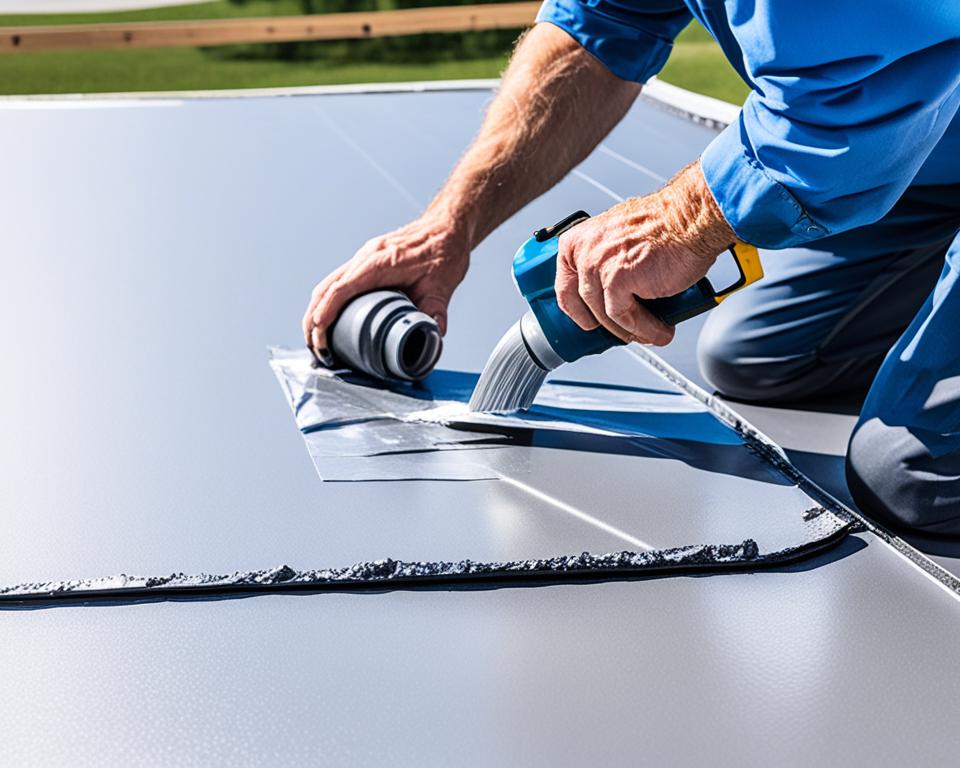
“Regular maintenance and inspection of the RV roof are crucial in preventing future leaks and costly repairs.”
By implementing these preventive measures and staying vigilant, you can protect your RV from roof leaks and ensure a worry-free travel experience. Don’t underestimate the importance of regular maintenance and inspection—it can save you time, money, and potential headaches in the long run.
How to Perform RV Roof Leak Repair
Performing an RV roof leak repair involves a step-by-step process to effectively fix the issue. Here are the essential steps to follow:
1. Identify the Source of the Leak
Start by thoroughly inspecting both the interior and exterior of the RV to locate the leak. Look for signs of water stains, damp spots, or pooling moisture. Pay close attention to seams around vents, skylights, and other openings where leaks commonly occur.
2. Apply a Temporary Fix
To prevent further water damage while preparing for the permanent repair, apply a temporary fix. Consider covering the RV with a weather-proof tarp or applying a patch to the problematic area. This provides immediate protection until the permanent repair can be done.
3. Thoroughly Dry the RV
Before proceeding with the permanent repair, ensure that the RV is thoroughly dried. This can be done by opening doors and windows to expose the RV to sunlight, using a dehumidifier and heaters, and wiping down damp surfaces with clean towels. Emptying the water holding tanks also helps remove any remaining moisture.
4. Determine the RV Roof Material
The type of repair needed depends on the material of the RV roof. Common materials include aluminum, fiberglass, rubber, vinyl, wood, or canvas. Identify the roof material to select the appropriate sealant for the repair.
5. Apply the Roof Sealant
Using the suitable sealant for the specific roof material, apply it to the damaged area. For example, aluminum roofs may require applying a sealant or caulk around the source of the problem, while fiberglass roofs may need a layer of liquid rubber coating. Follow the instructions provided by the manufacturer for best results.
Following these steps will help you fix a leaking RV roof on your own. Remember to take the necessary precautions and use the appropriate tools and materials to ensure a successful repair.
Identify the Leak
To address an RV roof leak, it is important to first identify the source of the leak. This can be done by performing a thorough inspection of the RV, both inside and outside.
Look for damp spots, pooling moisture, or water stains on the walls, ceiling, and floor. These signs can indicate the presence of a leaking RV roof.
Next, climb onto the roof and examine the surface. Pay close attention to the seams around vents, skylights, and other openings as these areas are prone to leaks.
If the source of the leak cannot be found, it may be necessary to call a specialist for a more detailed inspection. They have the expertise and tools to locate hard-to-find leaks and recommend the best course of action.
Signs of a Leaking RV Roof
It is important to be aware of the signs that can indicate a leaking RV roof. These signs include:
- Water stains on the ceiling, walls, or floor inside the RV
- Damp or musty smell
- Mold or mildew growth
- Visible cracks or gaps in the roof
- Drooping or sagging ceiling panels
- Water dripping or pooling inside the RV
If you notice any of these signs, it is important to take immediate action and address the leak before it causes further damage.
“Identifying the source of the leak is the first step in fixing an RV roof leak. By performing a thorough inspection of the RV, both inside and outside, you can locate the problem areas. Remember to pay close attention to the seams around vents, skylights, and other openings. If you’re unable to find the source of the leak, it’s always a good idea to seek professional help.” – RV Roof Repair Specialist
To summarize, identifying the source of a leaking RV roof is crucial for effective repair. By inspecting the RV both inside and outside, looking for signs of moisture and following the guidance of professionals if needed, you can locate the leak and begin the appropriate repair process.
Apply a Temporary Fix
Before starting the permanent repair, it is often necessary to apply a temporary fix to prevent further water damage.
One option is to cover the RV with a weather-proof tarp. A breathable and waterproof tarp provides excellent protection, shielding the RV from water exposure and minimizing the risk of leaks. Simply secure the tarp tightly over the affected area, ensuring it extends beyond the leaky spot to provide ample coverage.
Another temporary solution is to apply a roof patch directly to the problematic area. Rubber patches are commonly used to seal leaks temporarily. They are easy to apply and provide a reliable barrier against water intrusion. Make sure to clean the area thoroughly before applying the patch and press it firmly onto the surface for a secure seal.
These temporary fixes are effective in protecting the RV from further water damage while you prepare for the permanent repair. Whether you choose to use a weather-proof tarp or a rubber patch, these solutions provide a level of protection and peace of mind.
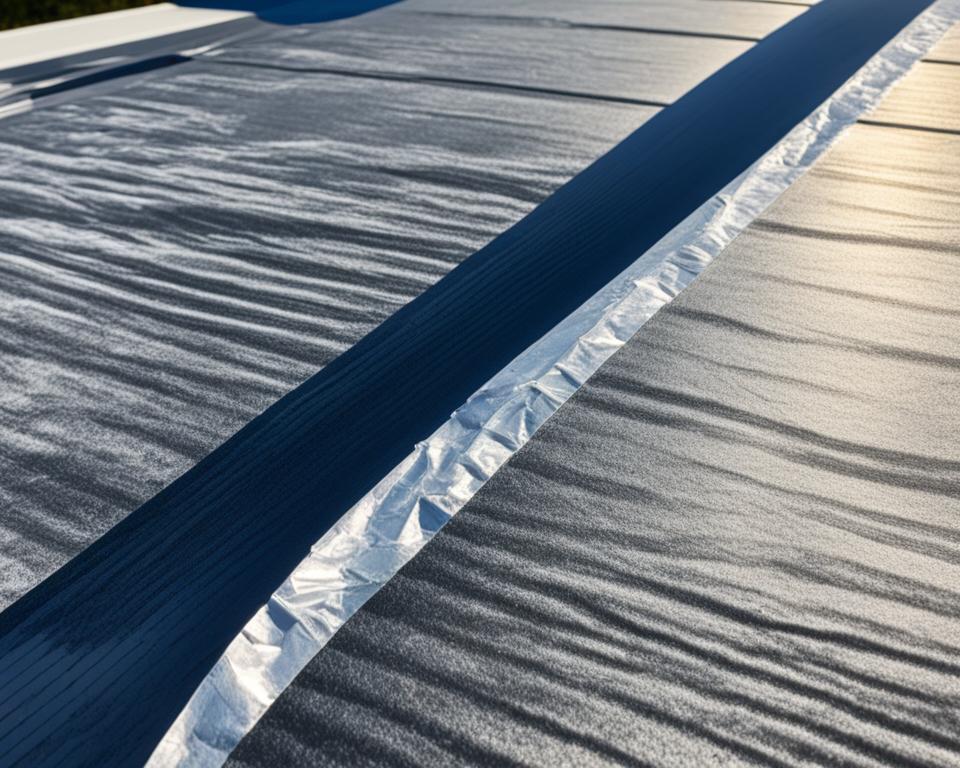
Key Points:
- Covering the RV with a weather-proof tarp is a temporary fix that shields the vehicle from water exposure.
- Applying a rubber patch directly to the leaky area provides a temporary seal against water intrusion.
- Thoroughly clean the area before applying a temporary fix to ensure maximum effectiveness.
- These temporary solutions offer protection while preparing for the permanent repair.
Thoroughly Dry the RV
Before starting the permanent repair, it is important to take the necessary steps to thoroughly dry the RV. This will ensure that the surrounding materials are prepared for the repair process, minimizing the risk of further water damage and optimizing the effectiveness of the repair.
To remove moisture from the RV, there are several tools and methods that can be used:
- Opening doors and windows: Allow fresh air and sunlight to circulate throughout the RV by opening doors and windows. This will help in evaporating any excess moisture.
- Using a dehumidifier and heaters: Invest in a dehumidifier and place it in your RV to help extract moisture from the air. Additionally, using heaters in the RV can help accelerate the drying process.
- Wiping down damp surfaces: Use clean towels to wipe down any damp surfaces in the RV. This will help remove residual moisture and prevent the growth of mold or mildew.
While drying out the interior of the RV is important, it is also recommended to empty out the water holding tanks. This will ensure that any remaining moisture is completely removed and will prevent the risk of further water damage during the repair process.
Properly drying the RV before roof repair is crucial as it creates an ideal environment for the permanent repair, allowing for better adhesion of sealants and ensuring a more effective and lasting fix.
Apply a Roof-Appropriate Sealant
When it comes to repairing an RV roof, choosing the right sealant is essential for a successful and long-lasting repair. The type of sealant used will depend on the material of the roof. Let’s take a look at the different options for each type of RV roof:
1. Aluminum Roofs:
For aluminum roofs, applying a sealant or caulk around the source of the problem is usually sufficient. Make sure to clean the area thoroughly before applying the sealant to ensure proper adhesion.
2. Fiberglass Roofs:
Fiberglass roofs can be repaired by applying a new layer of liquid rubber coating to the tears and weaknesses. This liquid rubber coating provides a durable and flexible barrier that helps prevent future leaks.
3. Rubber Roofs:
Rubber roofs can be fixed by applying a liquid rubber coating specifically designed for RV roofs. This coating creates a seamless and watertight layer that protects the roof from leaks. Alternatively, you can also use rubber repair kits for smaller repairs.
4. Vinyl Roofs:
Vinyl roofs may require the replacement of damaged panels. It is important to ensure that the replacement panels are properly sealed to prevent any future leaks. Consult with a professional or refer to the manufacturer’s guidelines for the specific replacement process.
5. Wood Roofs:
Wood roofs should be treated with waterproof coatings to protect them from water damage. Apply a high-quality waterproof coating that is specifically formulated for wood surfaces. This will help seal the wood and prevent any potential leaks.
6. Canvas Roofs:
Canvas roofs, typically found in pop-out campers, can be repaired using patching kits. These kits usually include adhesive patches that can be applied to the damaged area, providing a temporary or permanent seal, depending on the severity of the damage.
Choosing the appropriate sealant for the specific type of RV roof is crucial for a successful repair. It is recommended to consult with an RV professional or refer to the manufacturer’s guidelines for the best sealant option for your RV roof.
How to Prevent Leaks
Preventing roof leaks in RVs is crucial to avoid potential damage and costly repairs. By following these tips and implementing regular maintenance, you can protect your RV from leaks and ensure a worry-free travel experience.
Regular Inspection and Maintenance
Performing regular inspections of your RV roof is essential for leak prevention. Take the time to check for any signs of damage or debris that could potentially cause leaks. Clearing the roof of leaves, branches, and other debris helps to prevent clogs and ponding water, which can lead to leaks. Regularly cleaning the roof with gentle eco-friendly cleaners not only helps maintain its appearance but also assists in identifying any weaknesses or vulnerabilities.
Protect the Seals
The seals around vents and openings on your RV roof play a critical role in preventing leaks. Regularly inspect these seals to ensure they are tight and undamaged. Look for signs of wear, cracking, or gaps that may compromise their effectiveness. Applying a layer of sealant or caulk around these areas can help reinforce the seals and provide an extra layer of protection against leaks.
Post-Weather Inspection
After severe weather events, it’s important to inspect your RV roof for any potential damage or leaks. High winds, heavy rains, and hail can cause significant damage to your RV’s roof, leading to leaks if not addressed promptly. Take the time to carefully examine the roof and look for any visible signs of damage such as tears, cracks, or loose seals. Addressing these issues immediately can help prevent leaks and further damage.
Cover and Park Smartly
When your RV is not in use, consider covering it with a weather-proof tarp to protect it from the elements. This extra layer of protection can help prevent water from seeping in and causing leaks. Additionally, when parking your RV, choose dry areas whenever possible. Avoid parking under trees or in areas prone to flooding, as these conditions can increase the risk of leaks.
By following these RV roof leak prevention methods and implementing regular maintenance, you can safeguard your RV from potential leaks and avoid costly repairs. Remember to inspect your RV roof regularly, protect the seals, perform post-weather inspections, and park smartly to prevent water damage and maintain the integrity of your RV.
Conclusion
In conclusion, DIY RV roof leak repair is a practical and cost-effective solution for fixing leaks in RV roofs. By following the step-by-step guide and using the right tools and materials, RV owners can successfully repair their roofs and prevent further water damage.
Regular inspection and maintenance of the RV roof are crucial in identifying and addressing potential issues before they become major problems. Keeping the roof clean and free from debris, checking seals around vents and openings, and conducting post-severe weather inspections are key preventive measures to avoid future leaks.
By taking these actions and prioritizing regular roof inspection and maintenance, RV owners can ensure a safe and leak-free RVing experience. Protecting the integrity of the RV roof is essential in safeguarding the interior and belongings from water damage, ultimately extending the life of the RV.
FAQ
What are some DIY methods for repairing an RV roof leak?
Some DIY methods for repairing an RV roof leak include using RV Flex Repair Roof Tape and RV Flex Repair Self Leveling Caulking Lap Sealant for gaps and seams, as well as applying 100% Silicone RV Roof Coating to seal vents, air conditioning units, and skylights.
What tools and materials do I need to fix an RV roof leak?
To fix an RV roof leak, you will need tools such as a power washer, eco-friendly cleaner, and acetone as a primer. The essential materials include RV Flex Repair Roof Tape, RV Flex Repair Self Leveling Caulking Lap Sealant, and 100% Silicone RV Roof Coating.
How can I prevent future roof leaks in my RV?
To prevent future roof leaks in your RV, it is important to regularly inspect the roof for any signs of damage or debris. Keep the roof clean and free from debris, check the seals around vents and openings, and conduct inspections after severe weather events.
What is the process for performing RV roof leak repair?
The process for performing RV roof leak repair involves identifying the source of the leak, applying a temporary fix to prevent further water damage, thoroughly drying the RV, and then applying the appropriate sealant to fix the leak.
How can I locate the source of an RV roof leak?
To locate the source of an RV roof leak, perform a thorough inspection of the RV both inside and outside. Look for damp spots, pooling moisture, or water stains on the walls, ceiling, and floor. Check the seams around vents, skylights, and other openings.
What can I do for a temporary fix to stop water damage from an RV roof leak?
For a temporary fix to stop water damage from an RV roof leak, you can cover the RV with a weather-proof tarp or apply a roof patch to the problematic area. These temporary solutions provide protection while preparing for the permanent repair.
How can I thoroughly dry the RV before performing a roof repair?
To thoroughly dry the RV before performing a roof repair, open doors and windows to expose the RV to sunlight, use a dehumidifier and heaters, and wipe down damp surfaces with clean towels. Emptying out water holding tanks also helps remove remaining moisture.
How do I choose the right sealant for fixing an RV roof leak?
The type of sealant used for fixing an RV roof leak depends on the material of the roof. For aluminum roofs, sealant or caulk is usually sufficient. Fiberglass roofs can be repaired with liquid rubber coating. Rubber roofs may require specific repair kits, while vinyl roofs may need panel replacement. Wood roofs should be treated with waterproof coatings, and canvas roofs can be fixed with patching kits.
What can I do to prevent roof leaks in my RV?
To prevent roof leaks in your RV, regularly inspect the roof for any signs of damage or debris. Keep the roof clean and free of debris, check the seals around vents and openings to ensure they are tight and undamaged, and conduct inspections after severe weather events.
What is the importance of regular inspection and maintenance of an RV roof?
Regular inspection and maintenance of an RV roof are important to identify any potential issues before they become significant problems. It helps prevent leaks and costly repairs, ensuring a safe and leak-free RVing experience.

